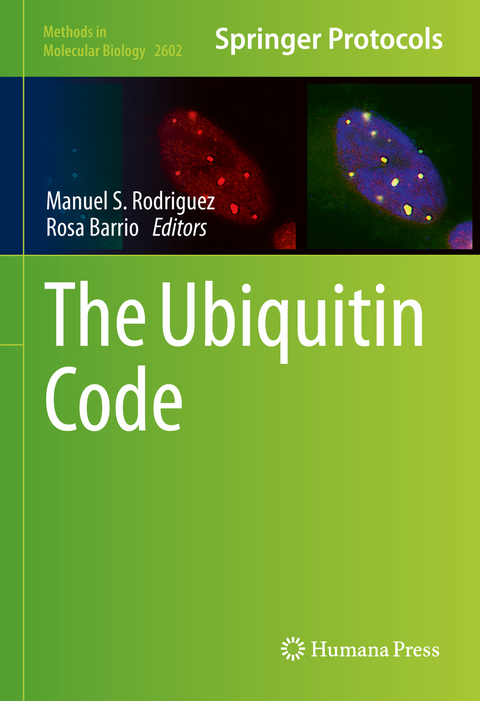
The Ubiquitin Code
Springer-Verlag New York Inc.
978-1-0716-2858-4 (ISBN)
Authoritative and cutting-edge, The Ubiquitin Code aims to to be a useful practical guide to researches to help further their study in this field.
Thioester and oxyester linkages in the ubiquitin system.- Getting to the root of branched ubiquitin chains: A review of current methods and functions.- Chemical synthesis of non-hydrolysable Ubiquitin(-like) hybrid chains.- Total Linear Chemical Synthesis of LC3A and LC3B.- A microbead-based flow cytometry assay to assess the activity of Ubiquitin and Ubiquitin-like conjugating enzymes.- Monitoring HECT ubiquitination activity in vitro.- RNAi-based screening for the identification of specific substrate-deubiquitinase pairs.- Strategies for monitoring ‘ubiquitin C-terminal hydrolase 1’ (Yuh1) activity.- Isolation and Mass Spectrometry Identification of K48 and K63 Ubiquitin Proteome using Chain-Specific Nanobodies.- A mass spectrometry-based strategy for mapping modification sites for the Ubiquitin-like modifier NEDD8.- Isolation of the hepatic ubiquitome/NEDDylome by streptavidin pull-down assay in the biotinylated ubiquitin (bioUb)/biotinylated NEDD8 (bioNEDD8) transgenic mice.- The Lambda display technology: a useful tool for the identification of ubiquitin and ubiquitin like-binding domains.- SUMO-ID: a strategy for the identification of SUMO-dependent proximal interactors.- Analysis of ATG8 family members using LC3-Interacting Regions (LIR)-based molecular traps.- A computational tool for analysis of mass spectrometry data of ubiquitin enriched samples.- In-plate and in-gel assays for the assessment of proteasome activity in Caenorhabditis elegans.- Isolation of Proteasome-Trapped Peptides (PTPs) for degradome analysis.
| Erscheinungsdatum | 02.12.2022 |
|---|---|
| Reihe/Serie | Methods in Molecular Biology ; 2602 |
| Zusatzinfo | 36 Illustrations, color; 9 Illustrations, black and white; XIII, 245 p. 45 illus., 36 illus. in color. |
| Verlagsort | New York, NY |
| Sprache | englisch |
| Maße | 178 x 254 mm |
| Themenwelt | Naturwissenschaften ► Biologie ► Biochemie |
| Naturwissenschaften ► Biologie ► Zellbiologie | |
| Naturwissenschaften ► Chemie | |
| Schlagworte | Gly-Gly antibodies • label free proteomics • SILAC • SUMO antibodies • Ubiquitin traps |
| ISBN-10 | 1-0716-2858-5 / 1071628585 |
| ISBN-13 | 978-1-0716-2858-4 / 9781071628584 |
| Zustand | Neuware |
| Haben Sie eine Frage zum Produkt? |
aus dem Bereich


